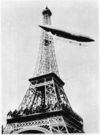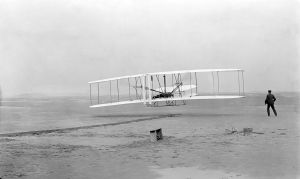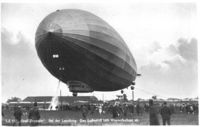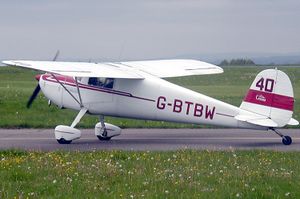PlaneSpottingWorld welcomes all new members! Please gives your ideas at the Terminal.
Aviation
Aviation refers to flying using aircraft, machines designed by humans for atmospheric flight. More generally, the term also describes the activities, industries, and regulatory bodies associated with aircraft.
Contents
History
There are records of early short-distance flights from the 9th to 11th centuries, such as the parachute flight of Armen Firman, the glider flight of Abbas Ibn Firnas, and possibly earlier human-carrying kites from China.
The modern age of aviation began with the first untethered human lighter-than-air flight on November 21 1783, in a hot air balloon designed by the Montgolfier brothers, and balloon flight became increasingly common over longer and longer distances throughout the 19th century, continuing to the present.
The practicality of balloons was limited by the fact that they could only travel downwind. It was immediately recognized that a steerable, or dirigible, balloon was required. Although several airships, as steerable balloons came to be called, were built during the 1800s, the first aircraft to make routine flights were made by the Brazilian aviation pioneer Alberto Santos-Dumont. Santos-Dumont effectively combined an elongated balloon with an internal combustion engine. On October 19, 1901 he became world famous when he flew his airship "Number 6" over Paris to win the Deutsch de la Meurthe prize. Santos-Dumont's success with airships proved that controlled and sustained flight was possible.
On December 17 1903, the Wright brothers flew the first successful powered, heavier-than-air flight, though their aircraft was impractical to fly for more than a short distance because of control problems. The widespread adoption of ailerons made aircraft much easier to manage, and only a decade later, at the start of World War I, heavier-than-air powered aircraft had become practical for reconnaissance, artillery spotting, and even attacks against ground positions.
Aircraft began to transport people and cargo as designs grew larger and more reliable. In contrast to small non-rigid blimps, giant rigid airships became the first aircraft to transport passengers and cargo over great distances. The best known aircraft of this type were manufactured by the German Zeppelin company.
The most successful Zeppelin was the Graf Zeppelin. It flew over one million miles, including an around the world flight in August of 1929. However, the dominance of the Zeppelins over the airplanes of the that period, which had a range of only a few hundred miles, was diminishing as airplane design advanced. The "Golden Age" of the airships ended on June 6, 1937 when the Hindenburg caught fire killing 36 people. Although there have been periodic initiatives to revive their use, airships have seen only niche application since that time.
Great progress was made in airplane design during the 1920s and 1930s. One of the most successful designs of this period was the Douglas DC-3 which became the first airliner that was profitable carrying passengers exclusively, starting the modern era of passenger airline service. By the beginning of World War II, many towns and cities had built airports, and there were numerous qualified pilots available. The war brought many innovations to aviation, including the first jet aircraft and the first liquid-fueled rockets.
After WWII, especially in North America, there was a boom in general aviation, both private and commercial, as thousands of pilots were released from military service and many inexpensive war-surplus transport and training aircraft became available. Manufacturers such as Cessna, Piper, and Beechcraft expanded production to provide light aircraft for the new middle class market.
By the 1950s, the development of civil jets grew, beginning with the de Havilland Comet, though the first widely-used passenger jet was the Boeing 707. At the same time, turboprop propulsion began to appear for smaller commuter planes, making it possible to serve small-volume routes in a much wider range of weather conditions.
Yuri Gagarin was the first human to travel to space on April 12, 1961, while Neil Armstrong was the first to set foot on the moon on July 21, 1969.
Since the 1960s, composite airframes and quieter, more efficient engines have become available, but the most important innovations have taken place in instrumentation and control. The arrival of solid-state electronics, the Global Positioning System, satellite communications, and increasingly small and powerful computers and LED displays, have dramatically changed the cockpits of airliners and, increasingly, of smaller aircraft as well. Pilots can navigate much more accurately and view terrain, obstructions, and other nearby aircraft on a map or through synthetic vision, even at night or in low visibility.
On June 21 2004, SpaceShipOne became the first privately funded aircraft to make a spaceflight, opening the possibility of an aviation market outside the earth's atmosphere.
Civil aviation
Civil aviation includes all non-military flying, both general aviation and scheduled air transport.
Scheduled airline service
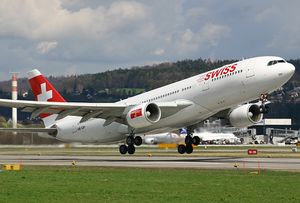
While there were many more in the past, there are currently only five major manufacturers of civil transport aircraft:
- Airbus, based in Europe (primarily France)
- Boeing, based in the United States
- Bombardier, based in Canada
- Embraer, based in Brazil
- Tupolev, based in Russia (scheduled to be merged into the United Aircraft Building Corporation)
Boeing, Airbus, and Tupolev concentrate on larger airliners, while Bombardier and Embraer concentrate on commuter aircraft.
Until the 1970s, most major airlines were flag carriers, sponsored by their governments and heavily protected from competition. Since then, various open skies agreements have resulted in increased competition and choice for consumers, coupled with falling prices for airlines. The combination of high fuel prices, low fares, high salaries, and crises such as the September 11, 2001 attacks and the SARS epidemic have driven many older airlines to government-bailouts, bankruptcy or mergers. At the same time, low-cost carriers such as Ryanair and Southwest have flourished.
General Aviation
General aviation includes any flight that is not military and does not fly on a regular schedule, ranging from a recreational flight in a hang glider to a non-scheduled cargo flight in a Boeing 747. The majority of flights on any day will fall into this category.
Because of the huge range of activities, it is difficult to cover general aviation with a simple description — general aviation may include business flights, private aviation, flight training, ballooning, parachuting, gliding, hang gliding, aerial photography, foot-launched powered hang gliders, air ambulance, crop dusting, charter flights, traffic reporting, police air patrols, forest fire flighting, and many other types of flying.
Each country regulates aviation differently, but typically, general aviation falls under several different types of regulations depending on whether it is private or commercial and on the type of equipment involved.
Many small aircraft manufacturers, including Cessna, Piper, Diamond, Mooney, Cirrus Design, Raytheon, and others serve the general aviation market, with a focus on private aviation and flight training.
The most important recent developments for small aircraft have been the introduction of advanced avionics (including GPS) that were formerly found only in large airliners, and the introduction of composite materials to make small aircraft lighter and faster. Ultralight and homebuilt aircraft have also become increasingly popular for recreational use, since in most countries that allow private aviation, they are much less expensive and less heavily regulated than certified aircraft.
Military aviation

Simple airships were used as surveillance aircraft as early as the 18th century. Over the years, military aircraft have been built to meet ever increasing capability requirements. Manufacturers of military aircraft compete for contracts to supply their government's arsenal. Aircraft are selected based on factors like cost, performance, and the speed of production.
Types of military aircraft
- Fighter aircraft's primary function is to destroy other aircraft. (e.g. Sopwith Camel, A6M Zero, MiG-29).
- Ground attack aircraft are used against tactical earth-bound targets. (e.g. Junkers Stuka diver bomber, Ilyushin Il-2, and the A-10).
- Bombers are generally used against more strategic targets. (e.g. Zeppelin, B-29 Superfortress, Tu-22, and the B-52)
- Surveillance aircraft have special capabilities used for reconnaissance (e.g. Rumpler Taube, de Havilland Mosquito, U-2, and MiG-25R).
Air Traffic Control (ATC)
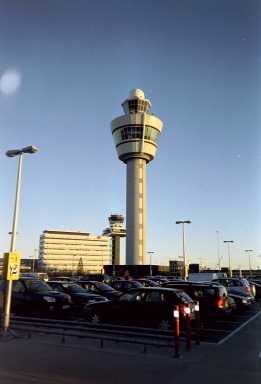
Air traffic control (ATC) involves humans (typically on the ground) who communicate with aircraft to help maintain separation — that is, they ensure that aircraft are far enough apart horizontally or vertically that there is no risk of collision. Controllers may co-ordinate position reports provided by pilots, or in high traffic areas (such as the United States) they may use RADAR to see aircraft positions.
While the exact terminology varies from country to country, there are generally three different types of ATC:
- control towers (including tower, ground control, clearance delivery, and other services), which control aircraft within a small distance (typically 10-15 km horizontal, and 1,000 m vertical) of an airport.
- terminal controllers, who control aircraft in a wider area (typically 50-80 km) around busy airports
- centre controllers, who control aircraft enroute between airports
ATC is especially important for aircraft flying under Instrument flight rules (IFR), where they may be in weather conditions that do not allow the pilots to see other aircraft. However, in very high-traffic areas, especially near major airports, aircraft flying under Visual flight rules (VFR) are also required to follow instructions from ATC.
In addition to separation from other aircraft, ATC may provide weather advisories, terrain separation, navigation assistance, and other services to pilots, depending on their workload.
It is important to note that ATC does not control all flights. The majority of VFR flights in North America are not required to talk to ATC at all (unless they're passing through a busy terminal area or using a major airport), and in many areas, such as northern Canada, ATC services are not available even for IFR flights at lower altitudes.
See also

|
| This article is part of the Transport series |
| Modes... |
| See also... |
| Topics | Portal |
External links
- Chasing the Sun - History of commercial aviation, from PBS
- Aviation Terms Glossary
Lists relating to aviation | |
|---|---|
| General | Timeline of aviation · Aircraft · Aircraft manufacturers · Aircraft engines · Aircraft engine manufacturers · Airports · Airlines |
| Military | Air forces · Aircraft weapons · Missiles · Unmanned aerial vehicles (UAVs) · Experimental aircraft |
| Notable incidents and accidents | Military aviation · Airliners · General aviation · Famous aviation-related deaths |
| Records | Flight airspeed record · Flight distance record · Flight altitude record · Flight endurance record · Most produced aircraft |
ar:طيران bs:Avijacija bg:Авиация cs:Letectví da:Luftfart de:Luftfahrt et:Lennundus es:Aviación eo:Aviado fa:هوانوردی fr:Activité aérienne gl:Aviación he:תעופה lt:Aviacija hu:Légi közlekedés nl:Luchtvaart ja:航空 pl:Lotnictwo pt:Aviação ru:Авиация sk:Letectvo sl:Letalstvo fi:Ilmailu sv:Luftfart tr:Havacılık uk:Авіація zh-yue:航空 zh:航空
